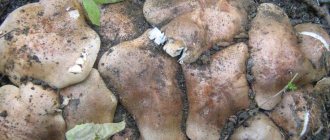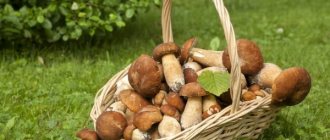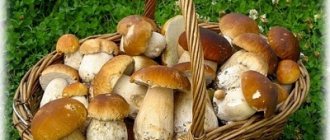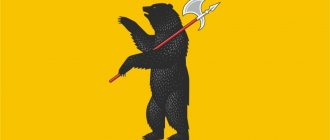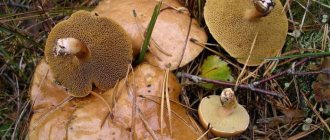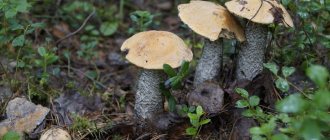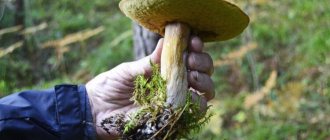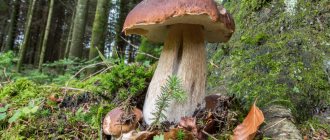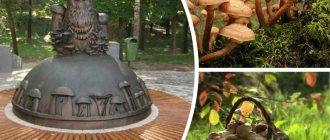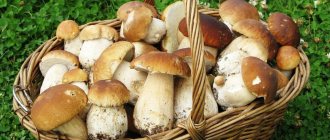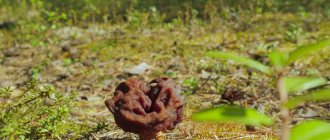Forests occupy more than six million hectares in the Novosibirsk region and vary greatly in their tree composition. Most of them are occupied by the so-called. “southern taiga”, in which coniferous trees (spruce, fir, pine, cedar) are mixed with deciduous trees - birch and aspen. At higher elevations there are also representatives of broad-leaved species: oak, elm, maple, linden.
In the north of the region there is a swampy taiga, in which larch is found among conifers, in the south there are deciduous forests with small tracts of broad-leaved trees, as well as vast areas of typical forest-steppe with pine forests and birch groves.
Expert opinion
Gennady Sergeevich Rylov
A great expert in mycology and an avid mushroom picker. Knows everything about mushrooms, their types and places of growth
The most inaccessible places in the taiga forest are of no interest to mushroom pickers. Not only because of the difficulty of moving through the taiga, but also mainly because of the scarcity of its mushroom reserves. The shading of taiga thickets and the piles of dead wood are more conducive to the development of tree fungi and wood destroyers than the tasty and healthy edible species we are accustomed to. But the light deciduous forests, pine and oak forests, and birch groves of the Novosibirsk region are exceptionally rich in mushrooms.
Secrets of mushroom fertility
Biologists have found that without the assistance of fungi, many tree species develop worse. But without the help of trees, it is also more difficult for mushrooms to gain strength for reproduction. This means that mushroom pickers cannot wait for fruiting bodies to emerge from the underground mycelium, which they call mushrooms.
Having settled on a tree, the fungus, with its tiny processes (hyphae), is woven into the root system and even penetrates into the roots themselves. Tree cells and mycelium hyphae jointly absorb nutrients from the soil. As a result of this interaction, the suction surface of the root system increases many times over, and the nutrition of both the tree and the fungus becomes more abundant and varied.
Expert opinion
Gennady Sergeevich Rylov
A great expert in mycology and an avid mushroom picker. Knows everything about mushrooms, their types and places of growth
The mycelium intensively processes the surrounding organic matter, and the tree uses its powerful roots to pump groundwater from the deep layers of the soil. Biologists call this symbiosis mycorrhiza.
Tree diversity in the forests surrounding Novosibirsk practically implies fungal diversity. After all, mushrooms have their own preferences among the flora.
Flag of the Novosibirsk region.
Volnushka
Volnushka or Volzhanka, as it is popularly called, prefers to grow in birch forests or mixed ones in well-lit areas among grass. It forms mycorrhiza with birch, mainly with aged trees. Sometimes found in wetter places. A good harvest of these mushrooms can be collected in the forests of the northern climate zone. Usually grows in groups, but single individuals are also found. The most favorable period for hunting for tremors begins at the end of July and lasts until the first half of September, although you can find this mushroom in June and October. The appearance of this mushroom looks like this:
- The cap is funnel-shaped, with a well-pressed center; as the mushroom matures, it takes on a flatter shape. The edges are turned down, and the surface is covered with thick, dense fibers arranged in the shape of concentric circles. The edge of the cap is well pubescent. The color is pink-orange, slightly reddish; in the sun the skin fades and becomes pale pink or whitish. The diameter rarely exceeds 10 cm, however, there are specimens with large cap sizes (up to 15 cm);
- the leg is short, up to 6 cm high and up to 2 cm thick, in the shape of a cylinder tapering towards the base or smooth, covered with fluff. It is very dense, but in adult mushrooms a cavity forms inside it. There are sometimes small pits on the outside. Surface color is pinkish;
- the flesh is fragile (in young mushrooms it is denser), cream or white in color; when damaged, it abundantly secretes white milky juice, which has a pungent taste and emits a light resinous aroma. At a break, when in contact with air, its shade does not change;
- the plates are frequent and narrow, descending along the stalk, of a whitish hue. There are also small intermediate plates;
- The spores are white.
Edible mushrooms of the Novosibirsk region
White mushrooms
Porcini.
Wherever they are collected, everywhere they are considered the best prey for a mushroom picker. The peculiar sweetish-spicy mushroom aroma is primarily associated with the aroma of white mushroom broth. This is the standard smell for all manufacturers of mushroom cubes and powders - no matter what they make it from, they are sure to try to copy the magical smell of boletus mushrooms.
Like real aristocrats, these mushrooms love comfort. You should look for them in cozy, clean coniferous or broad-leaved forests, slightly shaded, but light, penetrated by the sun's rays.
Their harvest is rarely very plentiful - they are too picky and there is great competition among mushroom pickers. But one boletus is enough to turn a large pot of soup into a delicacy.
Boletus and boletus
In principle, they are no different from each other. This was also noted by biologists, who combined these mushrooms into one type of “grandmother”. But boletuses are more valuable and look prettier. The reason for the external differences and unequal assessment of these related subspecies is the unpretentiousness of boletus boletuses and the increased demands of boletus boletuses on their growing areas.
As a result, they usually grow strong and clean, even looking like porcini mushrooms, while boletus mushrooms are long-legged and loose. Although the blackhead, grown in a birch grove, also looks like a white one and is in no way inferior to the aspen boletus.
mushroomgram
yakovya
Michelbeeckman
gubanovaolga18
Butter
Elegant oiler
The fact that these mushrooms have their loyal fans is not because of their ability to grow in large groups at once, but because of their pleasant taste in any culinary use. They will be a good accompaniment for porcini mushrooms in soup, make fried potatoes tastier and are absolutely irreplaceable in a marinade.
Pickling eliminates the smell of all mushrooms; all that remains is to compare them only by taste, consistency and appearance. Marinated boletus mushrooms are closest to the same porcini mushrooms, but they do not need to be cut into pieces, unlike large boletus mushrooms, so they look more beautiful and are more convenient to use as a snack.
Mokhoviki
Their main function is to help the basket fill up if this could not be done with the help of boletuses and boletuses. Their aroma when cooked is weaker, but they can easily add “mushroom” to any dish, be it soup or roast. They turn blue in the marinade, some people don’t like them for this, while others, on the contrary, consider them a table decoration.
Moss fly green.
Champignon
Those growing in the wild are inferior in taste and aroma to their cultivated counterparts. But they are rarely wormy, because they know how to choose good places for growth, and they sprout in whole clearings. When fried, they are not much different from russula, but they are much easier to process.
1-Common champignon. 2-Motley champignon.
Chanterelles
These mushrooms are better known in Europe than boletus and boletus. They have earned the love of mushroom pickers for their collectivism and for the fact that they are practically never wormy.
But they are also very good with fried potatoes, stewed vegetables and as a sauce for meat. And pharmacists obtain valuable substances from chanterelles for the manufacture of medicines.
Common chanterelle.
Milk mushrooms
White milk mushrooms are considered the best, especially aromatic and tasty when salted, with butter and onions or in sour cream. They compete with black milk mushrooms and milk mushrooms, but they are inferior in appearance and their aroma is weaker, because they need to be soaked and boiled longer before salting.
The breast is real.
boletus
The closest neighbor of the boletus is the boletus. This mushroom is beautiful and strong only when it is young. His hat at this time is dark in color. At this time he is strong and firm. When it gets old a little, it loses its appearance. On the tenth day, on his leg there is no longer a hat, but a hat. The flesh of this taiga mushroom is white when broken, but with further cooking it darkens, like that of boletus. It is no coincidence that both of these mushrooms are recognized as black.
Inedible species
Every person who is familiar with mushrooms only from restaurant menus or has successfully found them only in canned food in stores should consider all species that they encounter in the forest to be inedible. Any unidentified specimen may turn out to be a dangerous, poisonous grebe.
Soviet biologist B.P. Vasilkov developed a convenient classification of edible mushrooms, in which the last 4th category is reserved for mushrooms that chefs may consider delicacies, but which, in order to become a tasty and safe food, must undergo special testing and special processing. Otherwise, under the guise of a delicacy, the plate will turn out to be, at best, something bitter and disgusting, and at worst, a dangerous poison.
The 4th conditionally edible category includes the well-known and beloved morels and lines. The spring of 2022 pleased the residents of Novosibirsk with an abundance of funny morel caps in the warm meadows (especially in the area of the Pedagogical University), but only for those who know how to prepare them correctly.
1-Common morel. 2-Line ordinary.
The woman who found strange black chanterelles in the vicinity of Novosibirsk did exactly the right thing by photographing them and leaving them to grow without trying to test their culinary properties. Even though they turned out to be a popular delicacy in Europe, known to mycologists as “horned funnelweed.” They were even more likely to turn out to be something poisonous.
Black chanterelle.
The pig (or barn) can be considered the most dangerous of the conditionally edible animals. A strong, pure mushroom that does not taste bitter, gives fried potatoes a special aroma, and has a delicious crunch when roasted. But scientists have found that the pig (cow barn) absorbs toxins more intensively than other species. In addition, information has emerged about substances contained in pigs that have a detrimental effect on the human immune system.
The pig is fat.
Expert opinion
Gennady Sergeevich Rylov
A great expert in mycology and an avid mushroom picker. Knows everything about mushrooms, their types and places of growth
In the Novosibirsk region you can find a delicious truffle. But its conditional edibility is of a different kind: it is listed in the Red Book and its collection is punishable by a large fine. This applies to another 22 mushrooms of rare and endangered species growing in Novosibirsk forests.
Butter
There are several types of them. But in the taiga forests of Siberia and the Urals, the main one is oiler
, or, as it is also called,
granular oiler
. Its cap is covered on top with a yellowish-brown or brown thin but dense film, which is easily removed. But in damp weather, the film on the cap becomes sticky and slimy. In young fungi, the edges of the cap are connected to the stem by a white film, which over time comes off the cap and remains on the stem in the form of a dark ring. The spongy part of the cap is tender, light yellow, the stem is short. The flesh of the oiler is cool. You will take such a mushroom in your hand, like a piece of fresh butter from the refrigerator.
Mushroom places of the Novosibirsk region
- The most popular place among mushroom pickers is Karakansky Forest and its surroundings (Zavyalovo, Burmistrovo, Spirino). The area abounds in all types of edible mushrooms. If you have no luck with white ones, go to the Izdrevaya railway station for champignons, moss mushrooms and chanterelles.
- The Kudryashovsky forest will also delight you with white and white boletuses (aspen boletus and birch boletus).
- Academy Town: everything grows, but sometimes there are more mushroom pickers than mushrooms.
- They go to Matveevka for butter. But you can return from there with a basket of white or excellent boletus mushrooms.
- In Zaeltsovsky Park the competition is too great to pick a basket of whites, but you can always pick up honey mushrooms and russula.
- In Novolugovoye and the surrounding area of Moshkovo, mushrooms are collected for pickling, mainly trumpet mushrooms, but there are also milk mushrooms.
- Kamenka is rich in chanterelles and honey mushrooms, but there are photographs from there with full baskets of boletus and boletus mushrooms.
- In the Pervomaisky Forest you can find the entire elite assortment: porcini mushrooms and milk mushrooms. If you are unlucky, you can pick up boletus and boletus mushrooms.
- Koltsovo. If you're lucky, you'll get a basket of chanterelles in an hour. With more luck, in half a day - a basket of whites.
- Goose Ford will delight you with all subspecies of goose.
- Klyuch-Kamyshenskoe Plateau: excellent collection of boletus
- Mushroom places of the Iskitim region (Ust-Chem, Devkino, Legostaevo, Mosty) are rich in boletus, chanterelles and mushrooms. There are a lot of conditionally edible pigs.
Sokur, Morskoy State Farm, Kasmalinsky Bor, the entire Moshkovsky district, and Lnykha in the Toguchinsky district are also considered good.
Recreation center
On the territory of Karakansky Bor there are many recreation centers that differ in price category and living conditions. Among them, “Karakansky Bor”, “SKB”, boarding house “Sinemorye”, “Oasis”, etc. are especially popular.
All hotels, recreation centers, boarding houses and campsites near Karakansky Bor
© monson-1
"Oasis"
The recreation center "Oasis" is located near the village of Abrashino, on the shores of Lake Marmara. Vacationers combine swimming in the reservoir with excursions through the forest and swimming in the Ob Sea. Guests are offered cozy summer houses, as well as accommodation in a tent camp on the bay. At the base you can go diving under the guidance of an experienced instructor and receive a certificate allowing you to dive anywhere in the world. There are gazebos and parking available on site. Detailed information about living conditions can be found on the official website of the Oasis recreation center.
"SKB"
The recreation center of SKB OJSC "Sibelektroterm" is located in the heart of the Karakansky forest, on the shore of the Novosibirsk reservoir. Guests can rent summer and winter houses with stove heating. On the territory of the base there are picnic areas with barbecues, a sports ground with a volleyball net and a sandbox for children. A bathhouse is also open for vacationers. Detailed information about the recreation center is available on its official website.
© monson-1
Prices in 2022
Prices at recreation centers in Karakansky Bor are different. The cost of living for an adult per day starts from 450 rubles for a room and from 2000 rubles for a separate house. For a place for a tent you will have to pay at least 300 rubles, renting a barbecue costs from 200 rubles, a picnic in a wooden gazebo will cost 100 rubles per hour.
What is collected in spring, summer and autumn
The mushroom picker's calendar often starts in March and ends in November. But this is rather a tribute to the impatience of passionate mushroom hunters and the memory of an unusually early spring twenty years ago. For the mushroom fruiting bodies to appear promptly, the soil must be well warmed up. Therefore, there is no point in rushing to a “quiet hunt” before May. The exception is spring morels and strings, but these are mushrooms for connoisseurs. And with a large basket you can go mushroom hunting no earlier than mid-July.
If the weather corresponds to the time of year and is even a little warmer and rainier than usual, then mushrooms in the Novosibirsk region can be collected according to the following schedule:
| Month | What kind of mushrooms are there? |
| May | Champignons, chanterelles, boletus, mushrooms, russula. |
| June | White mushrooms, boletuses (boletus and boletus), champignons, chanterelles, boletus, moss mushrooms, russula. |
| July | White, obabka, champignons, champignons, chanterelles, boletus, moss mushrooms, russula. |
| August | White mushrooms, mushrooms, champignons, chanterelles, boletus, moss mushrooms, honey mushrooms, russula. Attention: it's time to collect milk mushrooms and milk mushrooms. |
| September | White mushrooms, mushrooms, champignons, chanterelles, butter mushrooms, moss mushrooms, honey mushrooms, russula, milk mushrooms (all types). |
A good mushroom October can simply be considered a continuation of September.
Weather
Winters in Karakansky Bor are long, harsh and snowy, and snowstorms and strong winds are often observed. The average January temperature is −18.9 °C; short-term thaws are possible. In spring and autumn, the weather is unstable; cold weather may return after established warmth, or early frosts may occur.
Summer is short, but warm. As a rule, during this period there is the most rain; the average temperature in July is +19.1 °C. In August it drops by a couple of degrees, in September it rarely exceeds +11 °C.
Weather in Karakansky Bor (in the village of Zavyalovo) for 10 days - Yandex. Weather
©
Valuy
Other names: goby
,
weeping mushroom
and
snot mushroom
. This taiga mushroom is easy to recognize. The hat of young Valuevs is like a small slippery ball, and those of older ones spread out with a flat roof. Some mushroom pickers do not collect valui, because if they do it, the basket will fill up very quickly. But why disdain these edible mushrooms, although they belong to the third category? So, mushroom pickers need to know that the valui goby is very tasty when pickled, when there is only one there, i.e. without admixtures of other taiga mushrooms. The best time to collect values is when they are born in herds. And there is no need to be afraid of the acrid taste of raw mushroom; it completely disappears when pickled. But it is better to salt the valui in a hot way, i.e. Boil for 10 minutes before salting.
Champignon
Light gray mushroom. The most popular and widespread mushroom in the world. In nature, champignons grow: in places with moist soil; on soil with a large amount of natural fertilizers; on lands rich in compost. In Russia, they can be found not far from human habitation, in the forest, in the meadow, in a forest clearing. The variety of species is so wide that it sometimes surprises even experienced mushroom pickers. The most common is the common meadow, which can be bought in any store and is successfully grown in a mushroom farm. All types of champignons are somewhat similar, but they also have noticeable differences. Meadow, or ordinary, is a white mushroom with a rounded cap, the edges of which are curved inward and pressed against the stem. Its weight ranges from 10 to 150 g. Meadow champignon is unpretentious and is able to grow near people’s homes, especially in rural areas. The cap changes shape as the mushroom grows. It retains its convexity, but becomes increasingly flatter. The plates underneath are loose, thin and wide. They are pinkish in color and gradually acquire a brown tint. The color of the cap itself is white, with grayish scales in the middle. There are meadow species with white-pink or gray caps, the surface of which is soft and silky to the touch. The stem of this mushroom is dense, fibrous, and quite wide. Its diameter reaches 1-3 cm. The height of the leg is 3-10 cm. It is smooth, widened at the base. While the mushroom is young, its cap is connected to the stem by a white blanket, but over time this connection disappears, and a thin white ring remains. It may persist or completely disappear with the growth of the fungus. A distinctive feature is its pulp, or more precisely, its color. Dense, white, when scrapped it changes, becoming pinkish. These mushrooms have a rather strong and pleasant mushroom aroma. Not just edible, but very tasty, meadow champignons are used to prepare a wide variety of dishes and are even eaten raw. You can distinguish edible champignons from similar poisonous mushrooms by their plates. In champignons they are dark in color, while in poisonous mushrooms they are light, sometimes yellowish. In terms of its dietary properties, it is inferior in calorie content to many of the mushrooms presented above.
Chanterelle
The mushroom is edible; culinary experts undeservedly included it in the third category. The fox got its name because of its yellow color. The fungus is like an egg yolk, and when there are a lot of them, it’s like a living omelette frozen on the grass. Take a closer look at them and see how the delicate yellow folds of the plates fancifully branch out all the way to the ground along the tapering stem. The sinuous and raked edges of the corrugated caps are beautiful. Chanterelles deserve not only the attention of mushroom pickers, but also respect. Chanterelles always grow in large families, sometimes occupying entire meadows. When young, the mushrooms are convex, quite neat, aligned, sometimes arranged in rows. The more “older” ones have a high leg, an even cap, they are fleshy, dense - the joy of a mushroom picker. But the smell of chanterelles is especially pleasant; it is typical for this type of mushroom, and it certainly cannot be confused with any other. Some mushroom pickers, praising mushrooms, describe this smell as a mixture of steamed birch leaves and mint. With age, only one thing changes in chanterelles: their elastic young body acquires a more rubbery structure, especially in dry weather, and becomes flabby in damp weather. Towards the end of summer, the cap of the mushroom takes the shape of a funnel, the edges of which often become uneven, as if torn. Chanterelles are especially loved by mushroom pickers because they are not damaged by parasites, thanks to their special chemical composition; except that the wireworm sometimes gets into the body of the chanterelle, but this happens very rarely. In addition, chanterelles are completely unpretentious to weather conditions; they can suddenly be discovered in the midst of summer, when there are very few mushrooms in the forest; this season is also called “inter-mushroom” by lovers of “quiet hunting”. Sometimes a mushroom picker wanders through the forest for a long time, especially if the weather is dry, looks at fallen trees, stirs up old leaves and suddenly comes out into a clearing strewn with chanterelles; even in dry times you can profit from these mushrooms by picking up quite a lot of them. The first chanterelles, depending on the area, do not appear at the same time, some a little earlier, others a little later, but already now, at the beginning of July, they are definitely there in the forest. Heaps, stripes, circles are the favorite placement options for fox families. By the way, you can collect chanterelles not only in baskets, but also in buckets, bags, backpacks, this is the only type of non-fragile mushroom, and even the most productive species, in any area, especially if there is enough moisture in the soil, chanterelles make up about a quarter of all mushrooms of mixed forests.
Gruzd
There are parchment mushrooms, yellow and black, but this one is dry. The cap is funnel-shaped on top, while the cap of the young mushroom is flat. The plates under the cap are frequent, the stem is dense, the same color as the cap; the pulp is brittle. Dry milk mushrooms have long been valued in Russian cuisine for their taste and aroma. One of the most popular edible mushrooms in Siberia, the Urals and the East European Plain. Dry milk mushrooms are common in coniferous and mixed forests. This species is called Russula delica, or podgrudok. In essence, it is a genus of russula. Real milk mushrooms are rare inhabitants of forests, they are much more difficult to find, they have a bitter milky juice. And the so-called dry milk mushrooms grow from July to October in birch groves, pine and coniferous forests, and their quantity can be simply incredible. It is very easy to detect these strong white creatures in the dry, dark soil of coniferous forests. The defenseless white color stands out against the dark background of the earth and fallen pine needles. But among the grass, the search becomes more complicated: you need to carefully look at each tubercle. Dry breast milk
has a white, smooth surface. In young fruiting bodies it has a slight bluish tint; the blue color on the back of the mushroom is even more noticeable. The diameter of the cap can reach 20 cm, while at first the shape is always convex with a small hole in the center, the edges are turned down. The older the dry milk mushroom (photo below), the more the cap opens, cracks in dry weather, and in rainy summers it is certainly eaten away by slugs and flies. Over time, yellow and brown spots appear over the entire surface. Dry milk mushrooms - lamellar mushrooms, with white dense flesh, without a pronounced taste or smell
